安装minio
首先点击进入MINIO官网,进行一个minio服务器的下载

下载好了之后在本地磁盘找一个文件夹,把下载的exe放入文件夹,再新建一个文件夹准备存放数据和文件
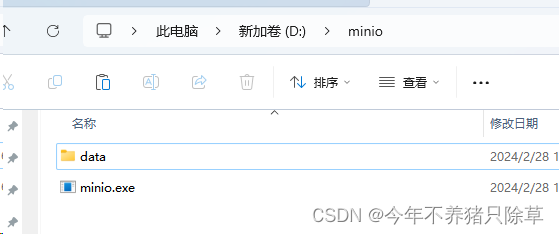
在当前目录cmd进入控制台,输入代码
minio.exe server data
成功后会有访问路径以及账号密码

访问这个路径,输入刚刚控制台打印的账号密码就可以进入
http://127.0.0.1:9000
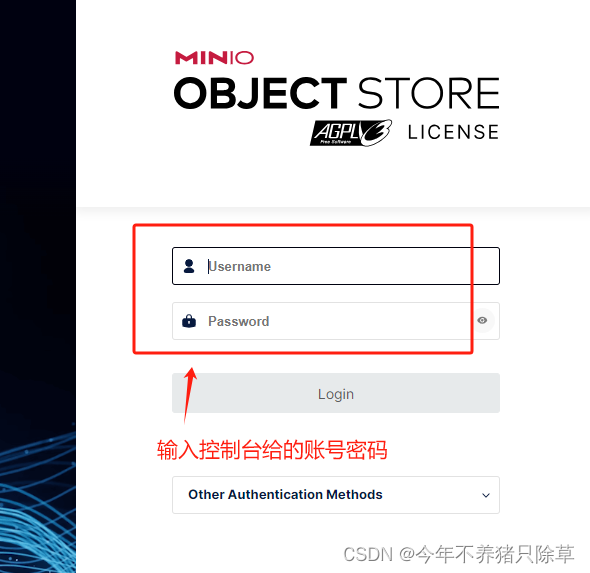
进入后创建buckets

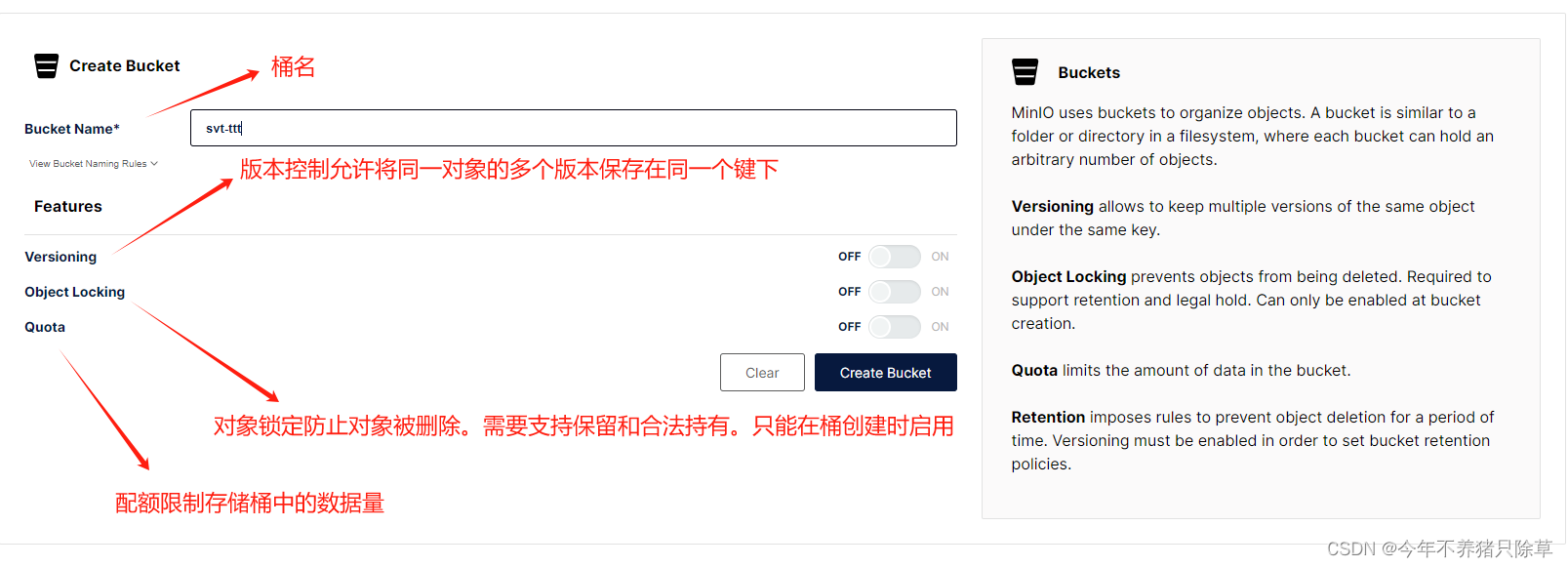
后端
在官网找到依赖并导入
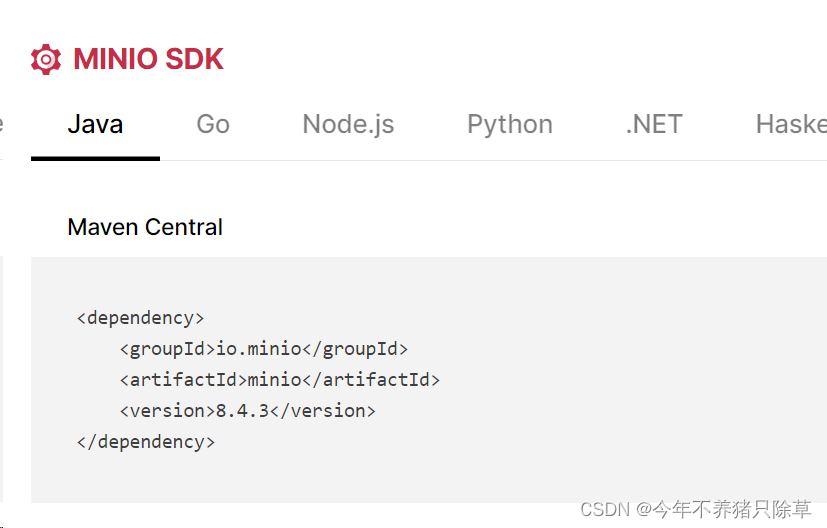
<dependency><groupId>io.minio</groupId><artifactId>minio</artifactId><version>8.4.3</version>
</dependency>
添加yml文件配置
# Minio配置 wyj配置
minio:endpoint: http://127.0.0.1:9000accessKey: minioadminsecretKey: minioadminbucketName: svt-ttt
MinIoClientConfig配置文件
这里bean文件只能有这一个,如果是多人团队项目开发记得在测试的时候协商好
@Value的注解导入是spring的原生注解
package com.wedu.config;import io.minio.MinioClient;
import lombok.Data;import org.springframework.beans.factory.annotation.Value;
import org.springframework.context.annotation.Bean;
import org.springframework.stereotype.Component;/** Minio的配置类* */
@Data
@Component
public class MinIoClientConfig {@Value("${minio.endpoint}")private String endpoint;@Value("${minio.accessKey}")private String accessKey;@Value("${minio.secretKey}")private String secretKey;@Value("${minio.bucket-name}")private String bucketName;/*** 注入minio 客户端** @return*/@Beanpublic MinioClient minioClient() {return MinioClient.builder().endpoint(endpoint).credentials(accessKey, secretKey).build();}}
工具类MinIOUtil
工具类里有很多可使用的方法,这里只用到了uploadFile
package com.wedu.modules.tain.utils;import com.amazonaws.util.IOUtils;
import com.wedu.modules.equi.entity.ObjectItem;
import io.minio.*;
import io.minio.messages.DeleteError;
import io.minio.messages.DeleteObject;
import io.minio.messages.Item;
import lombok.SneakyThrows;
import org.springframework.beans.factory.annotation.Autowired;
import org.springframework.beans.factory.annotation.Value;
import org.springframework.boot.context.properties.ConfigurationProperties;
import org.springframework.http.HttpHeaders;
import org.springframework.http.HttpStatus;
import org.springframework.http.MediaType;
import org.springframework.http.ResponseEntity;
import org.springframework.stereotype.Component;
import org.springframework.web.multipart.MultipartFile;import java.io.ByteArrayOutputStream;
import java.io.IOException;
import java.io.InputStream;
import java.io.UnsupportedEncodingException;
import java.net.URLEncoder;
import java.util.ArrayList;
import java.util.Arrays;
import java.util.List;
import java.util.stream.Collectors;@Component
public class MinIOUtil {@Autowiredprivate MinioClient minioClient;@Value("${minio.endpoint}")private String endpoint;@Value("${minio.access-key}")private String accessKey;@Value("${minio.secret-key}")private String secretKey;@Value("${minio.bucket-name}")private String bucketName;/*** 上传文件到指定的存储桶中** @param bucketName 存储桶名称* @param file 上传的文件* @param objectName 存储对象的名称* @param contentType 文件的内容类型* @return 文件上传的响应对象* @throws Exception 如果上传过程中发生异常*/@SneakyThrows(Exception.class)public ObjectWriteResponse uploadFile(String bucketName, MultipartFile file, String objectName, String contentType) {InputStream inputStream = file.getInputStream();return minioClient.putObject(PutObjectArgs.builder().bucket(bucketName).object(objectName).contentType(contentType).stream(inputStream, inputStream.available(), -1).build());}/*** description: 判断bucket是否存在,不存在则创建** @return: void*/public void existBucket(String name) {try {boolean exists = minioClient.bucketExists(BucketExistsArgs.builder().bucket(name).build());if (!exists) {minioClient.makeBucket(MakeBucketArgs.builder().bucket(name).build());}} catch (Exception e) {e.printStackTrace();}}/*** 创建存储bucket* @param bucketName 存储bucket名称* @return Boolean*/public Boolean makeBucket(String bucketName) {try {minioClient.makeBucket(MakeBucketArgs.builder().bucket(bucketName).build());} catch (Exception e) {e.printStackTrace();return false;}return true;}/*** 删除存储bucket* @param bucketName 存储bucket名称* @return Boolean*/public Boolean removeBucket(String bucketName) {try {minioClient.removeBucket(RemoveBucketArgs.builder().bucket(bucketName).build());} catch (Exception e) {e.printStackTrace();return false;}return true;}/*** description: 上传文件** @param multipartFile* @return: java.lang.String*/public List<String> upload(MultipartFile[] multipartFile) {List<String> names = new ArrayList<>(multipartFile.length);for (MultipartFile file : multipartFile) {String fileName = file.getOriginalFilename();String[] split = fileName.split("\\.");if (split.length > 1) {fileName = split[0] + "_" + System.currentTimeMillis() + "." + split[1];} else {fileName = fileName + System.currentTimeMillis();}InputStream in = null;try {in = file.getInputStream();minioClient.putObject(PutObjectArgs.builder().bucket(bucketName).object(fileName).stream(in, in.available(), -1).contentType(file.getContentType()).build());} catch (Exception e) {e.printStackTrace();} finally {if (in != null) {try {in.close();} catch (IOException e) {e.printStackTrace();}}}names.add(fileName);}return names;}/*** description: 下载文件** @param fileName* @return: org.springframework.http.ResponseEntity<byte [ ]>*/public ResponseEntity<byte[]> download(String fileName) {ResponseEntity<byte[]> responseEntity = null;InputStream in = null;ByteArrayOutputStream out = null;try {in = minioClient.getObject(GetObjectArgs.builder().bucket(bucketName).object(fileName).build());out = new ByteArrayOutputStream();IOUtils.copy(in, out);//封装返回值byte[] bytes = out.toByteArray();HttpHeaders headers = new HttpHeaders();try {headers.add("Content-Disposition", "attachment;filename=" + URLEncoder.encode(fileName, "UTF-8"));} catch (UnsupportedEncodingException e) {e.printStackTrace();}headers.setContentLength(bytes.length);headers.setContentType(MediaType.APPLICATION_OCTET_STREAM);headers.setAccessControlExposeHeaders(Arrays.asList("*"));responseEntity = new ResponseEntity<byte[]>(bytes, headers, HttpStatus.OK);} catch (Exception e) {e.printStackTrace();} finally {try {if (in != null) {try {in.close();} catch (IOException e) {e.printStackTrace();}}if (out != null) {out.close();}} catch (IOException e) {e.printStackTrace();}}return responseEntity;}/*** 查看文件对象* @param bucketName 存储bucket名称* @return 存储bucket内文件对象信息*/public List<ObjectItem> listObjects(String bucketName) {Iterable<Result<Item>> results = minioClient.listObjects(ListObjectsArgs.builder().bucket(bucketName).build());List<ObjectItem> objectItems = new ArrayList<>();try {for (Result<Item> result : results) {Item item = result.get();ObjectItem objectItem = new ObjectItem();objectItem.setObjectName(item.objectName());objectItem.setSize(item.size());objectItems.add(objectItem);}} catch (Exception e) {e.printStackTrace();return null;}return objectItems;}/*** 批量删除文件对象* @param bucketName 存储bucket名称* @param objects 对象名称集合*/public Iterable<Result<DeleteError>> removeObjects(String bucketName, List<String> objects) {List<DeleteObject> dos = objects.stream().map(e -> new DeleteObject(e)).collect(Collectors.toList());Iterable<Result<DeleteError>> results = minioClient.removeObjects(RemoveObjectsArgs.builder().bucket(bucketName).objects(dos).build());return results;}
}controller调用uploadFile
@Autowiredprivate MinIOUtil minIOUtil;@Autowiredprivate MinIoClientConfig minIoClientConfig;//minio@PostMapping("/minIoUpload")public R minIoUpload(@RequestParam("file") MultipartFile file) throws IOException {//文件名String fileName = file.getOriginalFilename();String newFileName = System.currentTimeMillis() + "." + StringUtils.substringAfterLast(fileName, ".");//类型String contentType = file.getContentType();minIOUtil.uploadFile(minIoClientConfig.getBucketName(), file, newFileName, contentType);return R.ok("上传成功");}
postman测试
测试成功
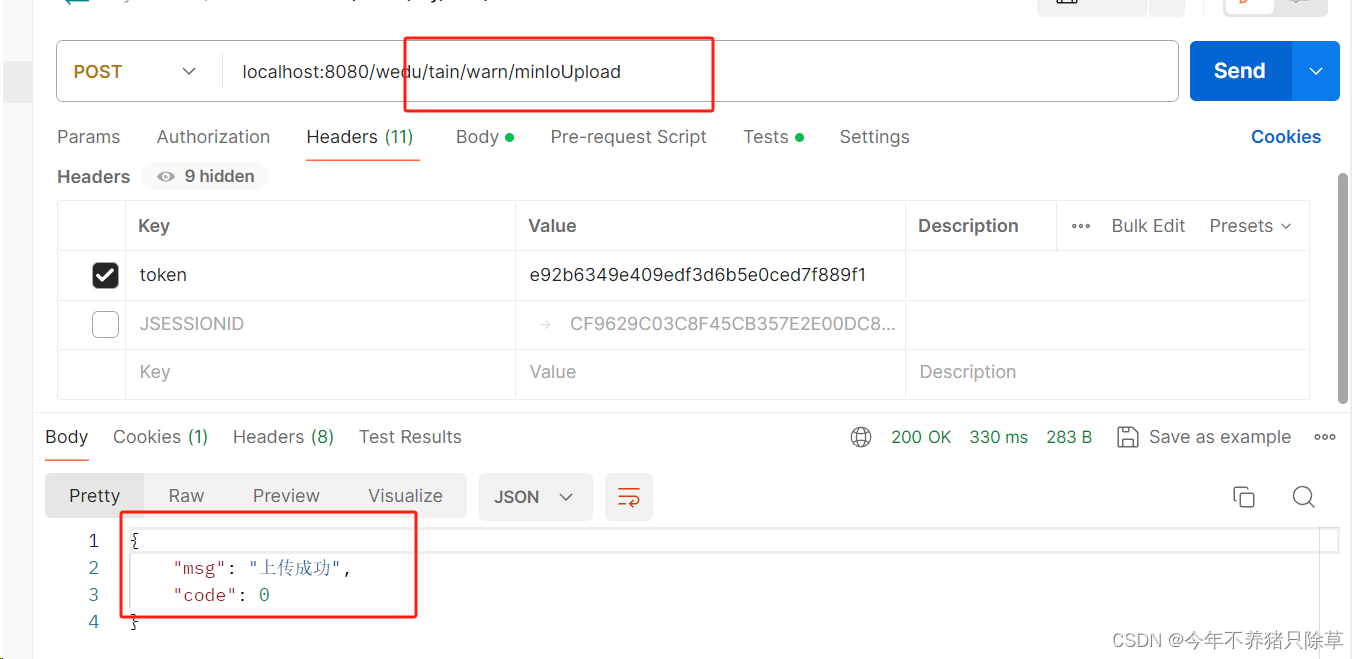
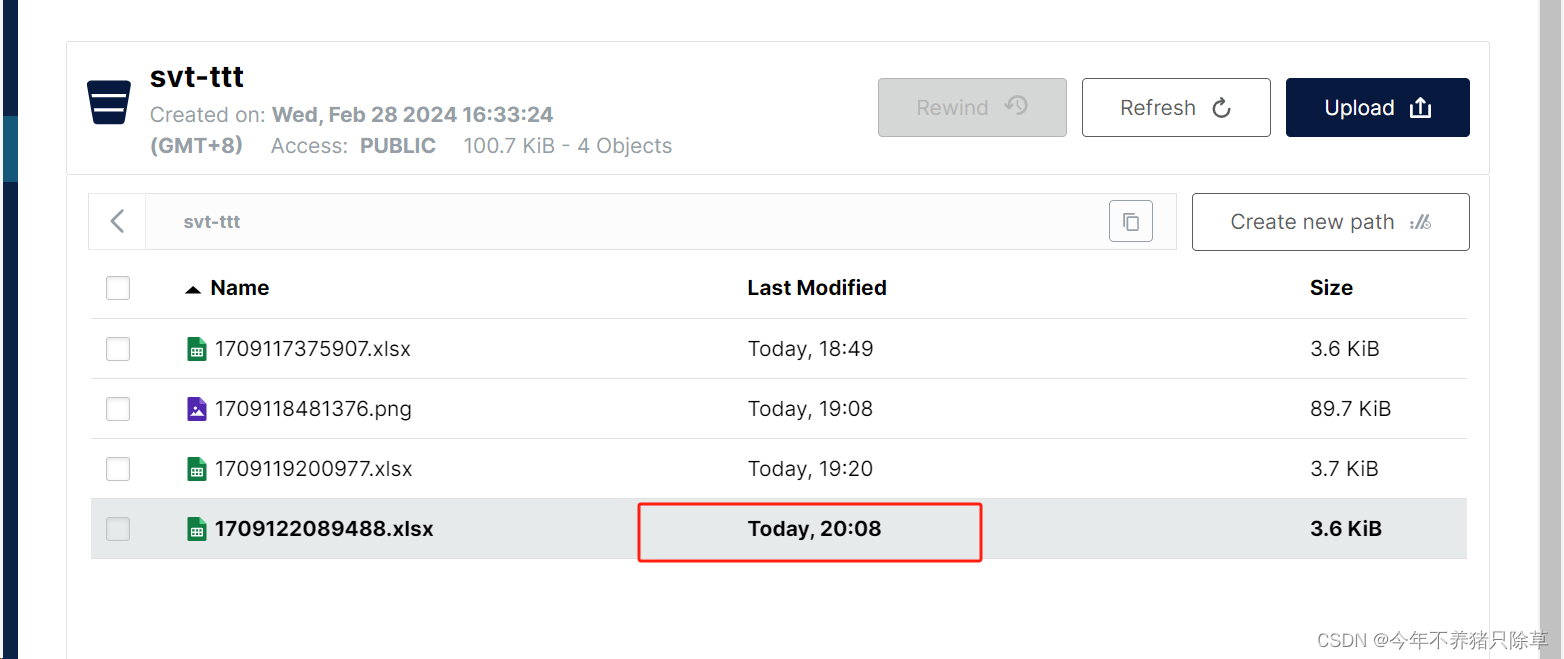
前端
主页面和springboot+vue实现oss文件存储一样,在弹窗的下拉框中添加一个2,访问路径变为自己的post的访问路径即可

)






)




一)

— 常量和字符串)


)
